Today’s coffee: Costa Rica
Yes, you read that correctly. Three typhoons. Typhoons don’t usually come to Hokkaido; we often get the outer fringes, but not direct hits. This year at the end of August, we got three direct hits in one week… global warming? Actually, Sapporo wasn’t right in the middle. Eastern Hokkaido got the worst of it, with torrential rain and landslides and flooding. In Sapporo we just got heavy rain.
 |
| View from our campsite. Katoributa (anti-mosquito-incense-pig) hangs from the canopy. |
But Keith and I had our heart set on a camping trip to eastern Hokkaido. Great hikes, gorgeous caldera lakes, delicious food… not to mention “Sunayu” (砂湯): the beach on Lake Kussharo (I’m going to call it “Kussharoko,” since “Lake Kussharo” sounds weird) where you can dig a hole in the sand and ONSEN WATER FILLS THE HOLE. We had to try it. Bad weather kept us from our Kussharoko camping trip early last summer, so we weren’t giving up this time, even though the typhoons had done a fair bit of damage to the area…
 |
| Keith is eyeing the debris piles for potential firewood. The shore of the lake should be behind the fence in the background... |
 |
| Oh no! Sunayu! |
… for example, Kussharoko’s water level was rather high, which meant that the famous Sunayu beach was completely underwater… sad face. Some parts of the campground were flooded. To get to the toilets, we had to cross three streams. I gave up keeping my feet dry, and wore flip-flops at all times. We won’t mention the number of bug bites I had on my feet.
But on the flipside, camping right next to the lake! Sunsets! Morning fog! Birds! (And crows. Stupid crows…)
 |
| Sunset over Kussharoko |
I was worried that we wouldn’t be able to hike because of landslides or downed trees, but the trails were clear and dry (except the flooded part next to Kussharoko). The biggest problem was fog over the peaks. The locals said the fog hadn’t lifted since the last typhoon. But the fog made for some interesting and dramatic scenery.
Our first hike was Mokotoyama. The fog lifted for a bit right when we got to the peak. We couldn’t see the lake, but we saw the sea of clouds covering the lake. We enjoyed watching a large number of hawks soaring around the peak.
 |
| Almost at the peak, and the fog lifted! |
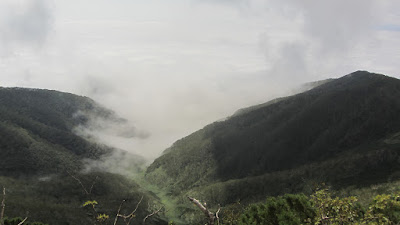 |
| Under the clouds, there's this really big lake... |
 |
| There were probably 15 hawks circling the peak. (Do hawks eat bugs?) |
The second hike was around the rim of Mashuuko (Lake Mashuu) to the peak of Mashuudake (Mt. Mashuu). It was a lovely, pleasant hike… it’s just that the peak was so swarming with bugs that we couldn’t stay there more than the 15 seconds it took to snap a picture of the sign as is my custom. Also, it was foggy. I’d love to do this one again on a day with less fog (and bugs).
 |
| Late-season wildflowers! |
 |
| Peak obscured by fog (and trees) |
 |
| Yeah. Not much point in staying here... possibly an all-time low for summit experiences. |
 |
| A bit of an autumn feeling... |
 |
| Finally can see the lake! |
 |
| Finished! Our destination is in the background (still obscured by fog) |
Camping culture is in some ways quite different than in the US. It’s rare for anyone to stay more than one night in the same campground. A lot of people travel alone by motorcycle, go to sleep when it gets dark, and leave as soon as it gets light, around 4 a.m.These sorts are pretty quiet and keep to themselves. But over the weekend… lots of families and big groups and loud parties. The campground was packed. I was glad to have earplugs. But it was nice to see families enjoying time together.
One group of guys occupied the space next to us for two nights. The first night they were up late… taking pictures of their kayaks by lamplight. I am not making this up.
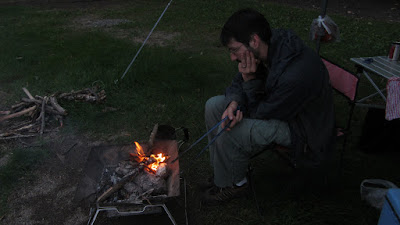 |
| Keith engages in his favorite hobby: making campfires. |
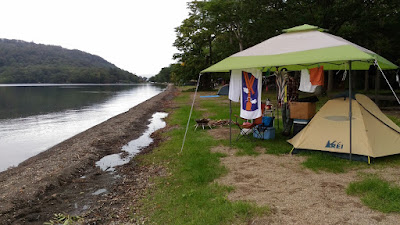 |
| Our campsite. The nearest onsen is right on the lake at the foot of the hill on the left. |
Kussharoko, being a caldera with an active volcano on one side, has lots of little onsen all along the lake, in addition to Sunayu. We could see one of them from our campsite. Unfortunately, we were not able to bathe in that particular onsen, because it was barely obscured from public view by a hedge, and even then it wouldn’t matter… because it was a mixed bath. We’re not quite that bold. Thankfully there was another onsen nearby--a rustic outdoor bath in the middle of the forest, with perfect temperature.
 |
| Foot bath in Kawayu Onsen town. So nice after a hike! |
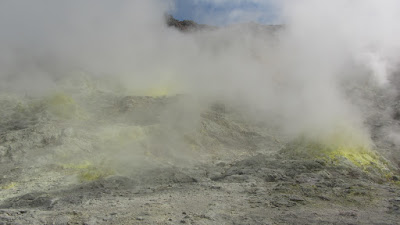 |
| Mt. Iou volcanic area |
 |
| The sign in English reads "Hot Spring!" (Yay! Let's get right in!) but the Japanese reads "Beware of burns." Hmmm... |
I’m happy to say that by the last day of our camping trip, the lake water had gone down somewhat, and we were able to dig our own onsen at Sunayu beach. I think most people just dig a bit, put their feet in the water, say “Sugoi! (Wow!)”, take their pictures, and get back on the tour bus. (Boring!) We, however, put on swimsuits and dug a hole big enough for both of us to sit in. Keith got all the way in. And we got some weird looks from the tour-bus crowd--two adult gaijin playing in the muddy water in the rain. “Metcha yogoreteiru!” (“That’s so dirty!”) said one. Lots of snarky replies went through my head, but I ignored her and pretended not to notice…
 |
| Yep. Water: very hot. No pictures of us sitting in the water, since my camera would have gotten dirty. |
Eastern Hokkaido is a magical place for food. Did you know that Hokkaido is the only prefecture in Japan that is self-sufficient for food and even exports to the rest of Japan? We ate many delicious foods, but I think my favorites were butadon while passing through Obihiro and the pizza with soba (buckwheat) flour crust.
 |
| Butadon!! |
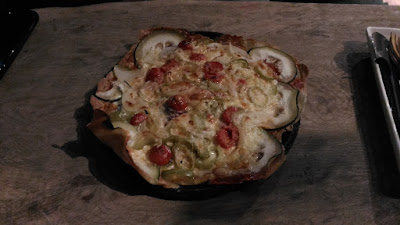 |
| Soba crust pizza with fresh local vegetables! I'm getting hungry again just looking at this picture... |
On Saturday night, we were in a bit of a bind. Missionaries don’t skip church, even when they are on vacation. After frantic searching on Google, we realized that the closest church was about 45 minutes away, over a mountain pass in Bihoro… and that our friends were serving in that church. And surprise! We got to witness their newborn daughter’s dedication! We headed back to their place a few days later for food and fellowship, including breakfast out in their favorite cafe, which a church member runs. I went home with an omiyage (souvenir) of two coffee seedlings.
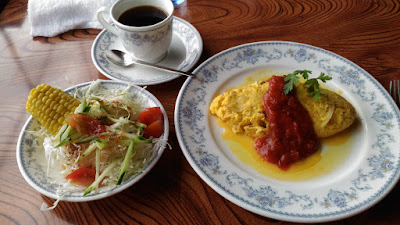 |
| I could eat this breakfast every day! |
 |
| I named them Kona and Sharon. |
All in all, I would highly recommend Kussharoko. Great place, lots of fun! But maybe don’t go right after three typhoons.
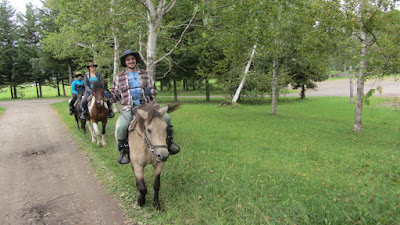 |
| Did you know that there are horses in Hokkaido? (Our Japanese textbook constantly reminded us.) Keith is riding a "Dosanko," which is a breed of horses from Hokkaido! |






